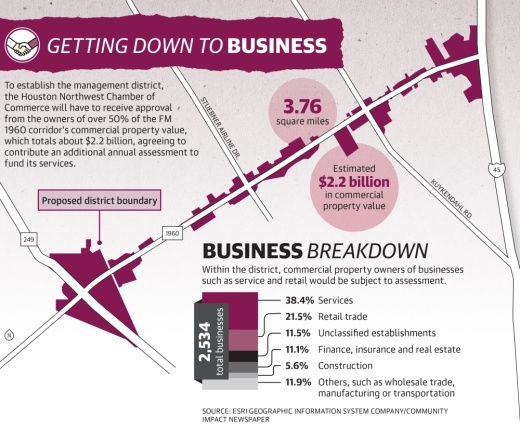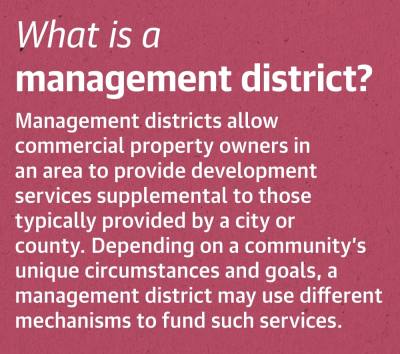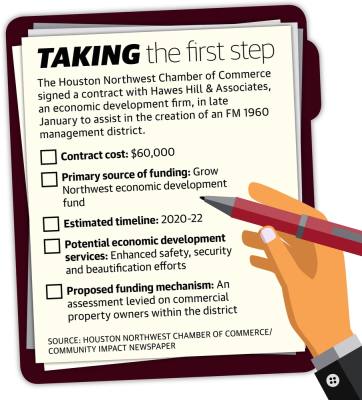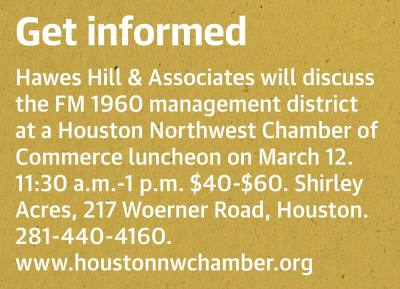The chamber signed a contract in late January with Hawes Hill & Associates, an economic development firm, to assist in the creation and administration of a management district along FM 1960 between Hwy. 249 and I-45. Upon creation, the management district would serve as a funding mechanism to provide services such as nuisance abatement, landscaping and additional law enforcement.
“There’s been a decline in the retail traffic ... [and] in the capital invested into a lot of the commercial properties [on FM 1960],” chamber President and CEO Bobby Lieb said. “We have abandoned strip centers that are sitting empty that are being vandalized. All of that is contributing to a decline in property values, and it’s contributing to a decline in economic activity.”
Under the $60,000 contract, funded through Grow Northwest, the chamber’s economic development fund, Hawes Hill & Associates will provide services to the chamber until the management district is approved by the Texas Commission on Environmental Quality—a process that could take up to two years, Lieb said.
However, the management district’s creation is contingent upon the majority of affected property owners agreeing to contribute an additional annual cost, similar to a tax, to fund it. As with previous revitalization attempts, the project has garnered both support and opposition from the community.
FALLING INTO DISARRAY
According to local resident and former property owner William Franks, the FM 1960 area has gone through many changes since he first moved to the once-rural area in 1979.
“It [was] like a poster child of the suburbs,” Franks said.
Since then, Franks said a lack of upkeep resulted in neglectful tenants and lower-quality properties.
Bill Mehrens, whose company SClay Management Inc. has owned commercial property along the corridor since 1978—including three shopping centers near FM 1960 and Kuykendahl Road—said he has seen a significant decline in his property value.
“Where my office is used to be by far our most valuable property in Texas,” Mehrens said. “But right now, our properties in Friendswood, Pearland and Katy are much more valuable just because of what’s happened here.”
Mike Willis owned the 18|8 Fine Men’s Salon that was located in the Champions Forest Plaza until it closed in late 2019. Willis said he believes many of the corridor’s challenges have contributed to the area’s economic decline.
“It seems like people are avoiding FM 1960 and using other roads, like Cypresswood [Drive], to conduct their business ... because of the way FM 1960 looks and the crime—those things are driving [customers and] businesses away,” Willis said.
Lieb said the chamber has made some aesthetic progress over the years by changing the corridor’s name to Cypress Creek Parkway, helping to implement green medians and adding the chamber’s logo to bus stop shelters along the road. However, Lieb said there is still work to be done.
AN ADMINISTRATIVE APPROACH
Over the last 15 years, two legislative attempts to establish a management district along FM 1960 spanning from Hwy. 249 to I-45 were made, but failed due to a lack of support, Lieb said. By contrast, the latest revitalization effort is taking an administrative route, which Lieb said does not require legislative approval.
According to David Hawes, senior partner at Hawes Hill & Associates, management districts allow a board of directors to implement services in an area supplemental to those typically provided by a city or county. Depending on a community’s unique circumstances and goals, a management district may use different mechanisms to fund such services.
Because FM 1960 is a commercial hub, similar to the Uptown Houston and Westchase districts, a management district would utilize services to drive economic growth, Hawes said.
“That could include additional safety and security initiatives, [such as] nuisance abatement on building violations ... [and] beautification, which includes landscaping, ... trash abatement, ... bandit sign removal [and] graffiti abatement,” Lieb said.
Now that a contract has been signed, the firm will draft a service plan outlining what improvements need to be made and how much each would cost.
To fund these services, the district would rely on a levied assessment on commercial properties within the district. Vacant and multifamily commercial properties would also be subject to the assessment, while single-family residential properties would not.
Before submitting an application to the TCEQ, a chamber task force must collect petitions from the owners of at least $1.1 billion worth of commercial properties within the district’s boundaries agreeing to be assessed—over 50% of the district’s total $2.2 billion commercial value.
Once the majority of commercial property value is collected through petitions and the district is approved, all commercial property owners within the boundaries would be charged an annual assessment rate, similar to a tax. According to Hawes, property owners in a management district are commonly charged 8-10 cents per $100 of property value.
Lieb said the firm will be working with the chamber’s task force to further discuss what services will be needed in the district. The chamber also plans to hold public outreach events to gain community feedback.
MIXED RESPONSE
Many property and business owners have voiced both support for and opposition against a management district.
Mehrens, who serves as the president of the Cypress Creek Parkway Business and Property Owners Association, said the organization, which works to improve FM 1960, has been unable to accomplish much in recent years due to a lack of funding. As a management district would serve to provide funding for services to the area, Mehrens said he is in favor of the project.
“There’s a handful of absentee property owners who don’t keep up their property, which really hurts all of us who really try to do a good job,” Mehrens said. “We can keep our property nice, but we can’t do anything about the property across the street or down the road.”
However, like every project, the creation of a management district comes at a cost. As a former small-business owner along the corridor, Willis said even the smallest additional costs put on a struggling business owner could “break the camel’s back.”
“Taxes on any business are a challenge and especially the small business that’s struggling,” Willis said. “A lot of times, that can be the death of them. But at the same time, the benefits of [the management district] are going to be reaped by the businesses, so they’ve got to recognize that, too.”
Vicky Rodgers, who owns D’Ann’s Wig Salon near FM 1960 and Ella Boulevard, said she would need to see some good examples of places where management districts have been successful before jumping on the bandwagon.
“I’m pretty reasonable, I’m not looking for a guarantee but I want to see some proof—show me a district where you guys have worked and show me it before and after,” she said.
However, Tommy Ripley, who owns Ripley’s Muffler & Brakes on FM 1960, said he believes a management district will be pivotal in determining the corridor’s future.
“I pay more taxes to live in my neighborhood because I want to live in a nicer community, and I think the same would be true with [FM 1960],” Ripley said. “The area’s only gotten worse, so we’ve got to do something before it’s lost.”










